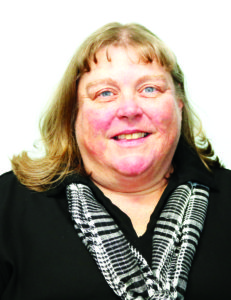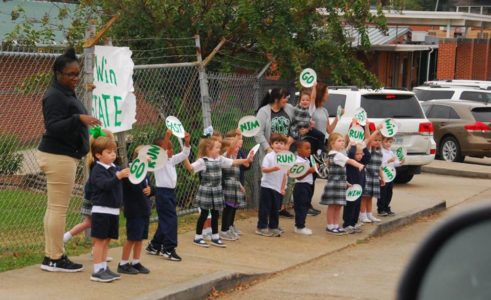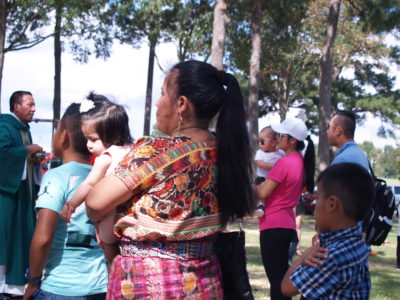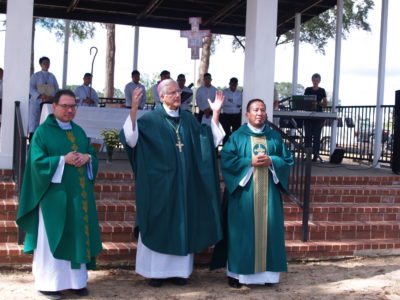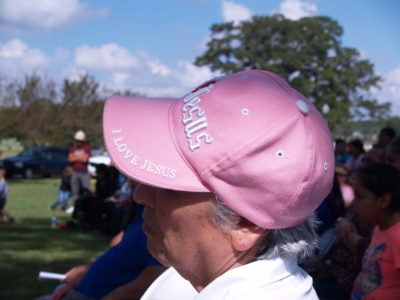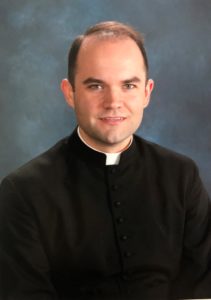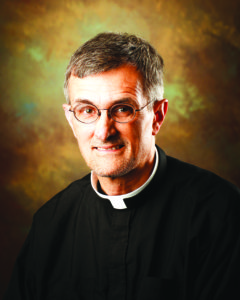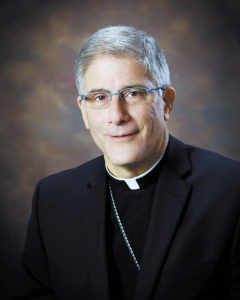
Obispo Joseph R. Kopacz
Por Obispo Joseph Kopacz
Durante el mes de noviembre, nos encantamos con el esplendor de la Fiesta de todos los Santos y la Conmemoración de Todos los Fieles Difuntos. La verdadera nube de testigos (Hebreos 12,1), algunos canonizados oficialmente, la mayoría no, nos recuerdan que nuestra ciudadanía está en el cielo con Jesucristo, el camino, la verdad, la resurrección y la vida.
Desde la Fiesta de todos los Santos la visión de San Juan, en el libro de Apocalipsis, nos permite entrever la eternidad en “una enorme muchedumbre, imposible de contar, formada por gente de todas las naciones, familias, pueblos y lenguas. Estaban de pie ante el trono y delante del Cordero, vestidos con túnicas blancas; llevaban palmas en la mano y exclamaban con voz potente: ¡La salvación viene de nuestro Dios que está sentado en el trono, y del Cordero!” (Apocalipsis 7, 9-10)
El 13 de noviembre en Baltimore, en la reunión anual de la Conferencia de Obispos Católicos de los Estados Unidos, presentaré formalmente la Causa para la Canonización de la hermana Thea Bowman, FSPA, Sierva de Dios, afroamericana, de la ciudad de Canton, en el seno de la Diócesis de Jackson, a quienes declaramos con fe ser una miembro de la Nube de Testigos.
Mucho se sabe de su vida, pero me gustaría iluminar sus últimos seis años. En 1984, la hermana Thea, hija única, sufrió la muerte de sus queridos padres, el Dr. Theon y Mary, y ese mismo año a ella le diagnosticaron cáncer. Con la presión de la mortalidad, y comprendiendo la gravedad de su enfermedad, proclamó valientemente que “viviría hasta que muriera”.
De hecho, así lo hizo, viajando, evangelizando, enseñando, cantando e inspirando hasta el final.
En 1984, en la escena nacional, los Obispos Católicos Negros de los Estados Unidos emitieron una Carta Pastoral sobre la Evangelización llamada “Lo que hemos visto y oído”. Esta carta fue publicada cinco años después de la publicación en 1979 de la Carta pastoral contra el racismo titulada “Hermanos y hermanas para nosotros”, de la Conferencia de Obispos de Estados Unidos.
En junio de 1989, diez años después de la primera carta contra el racismo, y cinco años después de la segunda, la hermana Thea fue invitada a hablar en la Conferencia de Obispos en la Universidad Seton Hall. Su testimonio, canción y palabras en esa ocasión encarnaron, en gran parte, lo que estaba escrito en las Cartas pastorales anteriores.
“Lo que hemos visto y oído” agradecía a los primeros misioneros que plantaron la semilla del Evangelio en las familias y comunidades afroamericanas. En su discurso a los obispos, la hermana Thea ofreció su gratitud a los discípulos misioneros en su vida cuando dijo. “Los cristianos católicos llegaron a mi comunidad y nos ayudaron con la educación, nos ayudaron con el cuidado de la salud, nos ayudaron a encontrar respeto propio y a reconocer nuestras capacidades cuando el mundo nos dijo durante tanto tiempo que no éramos nada y no llegaríamos a nada. Yo quería ser parte de ese esfuerzo. Eso es cristianismo radical, eso es catolicismo radical … Me atrajo examinar y aceptar la fe católica debido al ejemplo cotidiano de los cristianos católicos ante todo me amaron y luego compartieron conmigo su historia, sus valores, sus creencias; a quienes primero me amaron y luego me invitaron a compartir con ellos en comunidad, oración y misión. De niña, yo no reconocí el trabajo de la evangelización en mi vida. Reconocí solo amor, servicio, comunidad, oración y fe”.
“Lo que hemos visto y oído” manifestó conmovedoramente el don de la reconciliación arraigado en el sufrimiento, la liberación y la justicia, que la experiencia afroamericana podía ofrecer a la Iglesia, a la nación y al mundo. “Sin justicia, cualquier reconciliación significativa es imposible. La justicia salvaguarda los derechos y delinea las responsabilidades de todos. Un pueblo debe proteger su propia identidad cultural y sus propios valores culturales. Asimismo, deben respetar los valores culturales de los demás. Por esta razón, la reconciliación sincera se basa en el reconocimiento mutuo y el respeto mutuo. Sobre esta base se puede erigir un auténtico amor cristiano. La escritura testifica: ‘Pero ahora, unidos a Cristo Jesús por la sangre que el derramó, ustedes, que una vez estuvieron lejos, se han acercado. Porque él es nuestra paz, el que hizo las dos cosas y derribó el muro divisorio de la enemistad, a través de su carne’-(Efesios 2, 13-14).
Buscamos la justicia entonces, porque
buscamos la reconciliación, y buscamos la reconciliación porque por la sangre de Cristo somos hechos uno. El deseo de reconciliación para nosotros es el regalo más precioso, porque la reconciliación es el fruto de la liberación. Nuestra contribución a la construcción de la Iglesia en América y en el mundo es ser un agente de cambio para ambos”.
Hacia el final de su vida, la hermana Thea se hizo eco de las palabras de su hermano Obispos. “Nos unimos a la obra redentora de Cristo, cuando nos reconciliamos, cuando hacemos la paz, cuando compartimos la buena noticia de que Dios está en nuestras vidas, cuando reflexionamos a nuestros hermanos y hermanas la sanidad de Dios, el perdón de Dios, el amor incondicional de Dios”.
A principios de este año, el Papa Francisco publicó la Exhortación apostólica sobre la santidad, Guadete et Exultate, traducida, Alégrate y Regocíjate, las propias palabras de nuestro Señor desde las bienaventuranzas que ilumina sobre las exhortaciones anteriores del Santo Padre sobre la alegría del Evangelio y la alegría del amor. La hermana Thea habría pedido un Amén o dos sobre estas exhortaciones.
“Lo que hemos visto y oído” presentó elocuentemente un regalo de la alegría como algo esencial para entender la espiritualidad afroamericana que la hermana Thea vivió magnánimamente. “La alegría es lo primero de una celebración. Celebración es movimiento y canción, ritmo y sentimiento, color y sensación, júbilo y acción de gracias. Celebramos la presencia y la proclamación de la Palabra hecha carne. La alegría es un signo de nuestra fe y especialmente de nuestra esperanza. Nunca es un escape de la realidad “.
Como un discípulo misionero alegre por siempre, la hermana Thea nos exhorta ” ¡Niños, madres, padres, hermanas y hermanos, vayan! Hay una canción que nunca se cantará a menos que la canten. Hay una historia que nunca se contará a menos que la cuentes. Hay un gozo que nunca se compartirá a menos que lo demuestres. Ve a decirle al mundo. Ve y predica el Evangelio. Ve y enseña la Buena Nueva. Dios Es. Dios es amor. Dios es con nosotros. Dios está en nuestras vidas “.



